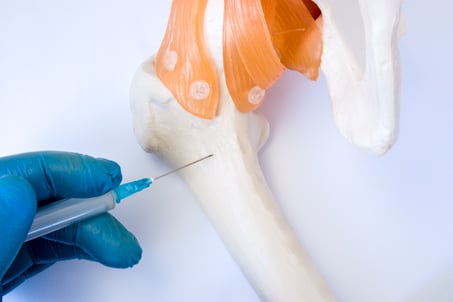What to Expect from a Bone Marrow Biopsy: 5 Questions Answered
5 min read

Early symptoms of leukemia and other blood cancers can be subtle. You might feel a little sluggish, have a fever or chills, and experience pain — all symptoms that could be confused with the flu or another health problem. Still, if your healthcare provider sees something to be concerned about in a blood test, you might be referred for a bone marrow biopsy.
When Should a Bone Marrow Biopsy Be Done?
Reasons for a bone marrow biopsy usually focus on diagnosing or helping guide treatment for a particular health issue.
“A bone marrow biopsy is used to help diagnose and evaluate certain types of blood cancers, such as multiple myeloma, leukemia, and lymphoma, as well as several other blood disorders,” said Laura Traylor, NPc, advanced oncology certified nurse practitioner at Rocky Mountain Cancer Centers (RMCC). “The bone marrow is a production site of circulating cells in our body, so a bone marrow biopsy is an important piece of the evaluation and considered the gold standard for the most accurate diagnosis.”
When problems arise with bone marrow, your body may make too few or too many blood cells, and that can cause health issues. In addition to blood cancers, a bone marrow biopsy can help detect:
- Anemia and other noncancerous blood disorders
- Blood disorders that affect red blood cells, white blood cells, or platelets, which control blood clotting
- Bone marrow disorders
- Bone marrow infections that can cause unexplained fever
If you’ve been diagnosed with cancer, bone marrow biopsies can be helpful to provide information to your oncologist during your treatment. Your doctor may order a bone marrow biopsy for any of the following reasons:
- Determining whether your cancer has spread to bone marrow
- Initial diagnosis of blood cancers, including multiple myeloma
- Monitoring your response to treatment
How Long Does a Bone Marrow Biopsy Take?
“Bone marrow biopsies sound intimidating, but they are performed in less than an hour in RMCC offices,” Laura said.
The procedure involves taking a sample of your bone marrow, which is sent to a laboratory. A pathologist will then look at the bone marrow, blood, and bone under a microscope to check for signs of a health condition or for one of the other purposes listed above.
As you lie on your stomach or side, a provider cleans the biopsy area and gives you local anesthesia. He or she will make a small incision about a centimeter long through which the biopsy will be taken. The incision is small enough to not require stitches.

To take the sample, your provider inserts a hollow needle through the incision and collects a sample of bone and bone marrow. The sample is about 1 centimeter long and roughly the diameter of a pencil lead. The biopsy provider will also remove several milliliters of a bloody substance in the bone called aspirate. Most of the time, the bone marrow biopsy is taken from the back side of your hip bone. In some isolated cases, it can come from your breastbone or another part of your body.
Once the sample is taken, your provider will bandage the area and give you an ice pack to help reduce bruising and swelling. You’ll need to keep the bandage on for 24 hours.
If you’re nervous about having the biopsy, RMCC providers can make arrangements to have it done under conscious sedation, in which you receive medication to help you relax but are still awake. Conscious sedation, however, can add time to the procedure and require additional precautions, such as having a driver available to take you home.
How Painful Is a Bone Marrow Biopsy Procedure?
Most people feel slight stings and various levels of pressure during the biopsy.
“The surface of the skin is numbed with a small needle that generally causes a minimal bug-bite-like sting,” Laura said. “A thin needle is used to numb the surface of the bone, which produces a tapping sensation. The removal of bone with a coring needle is typically described as low-level pressure.”
You might also feel a negative pressure sensation as the sample of bone, bone marrow, and aspirate is taken, Laura added.
Following the procedure, you may feel stiffness or soreness at the site of the biopsy. To treat bone marrow biopsy pain, acetaminophen or another over-the-counter pain reliever should be all you need after the numbing medication wears off.
On rare occasions, you might have bone marrow biopsy side effects that include:
- Bleeding or loss of other fluids at the incision site
- Fever
- Infection, redness, and swelling at the incision site
- Localized pain or discomfort that increases over time
If you have any of these symptoms, you should contact your healthcare provider right away.
How Long Does It Take to Recover from a Bone Marrow Biopsy?
Once you’re cleared to go home, recovery from bone marrow biopsy is typically quick, and you can continue daily activities as soon as you feel up to it.
“The only limitation is not submerging the biopsy site in water until the skin is healed, which generally takes a couple of days,” Laura said. “You should also avoid showering until 24 hours and not lift more than 20 pounds for two days after the procedure. Patients can drive and perform light work that day and resume normal activities 24 hours later.”
If you have any questions about what you should and shouldn’t do after the biopsy, talk with your care team.
What Do Positive or Negative Bone Marrow Biopsy Results Mean?
“Positive” results mean something abnormal was found in your bone marrow, and your doctor may want to begin treatment for cancer, a blood or bone marrow disorder, anemia, or whatever condition the test reveals you have. Depending on your condition, your doctor may order additional tests to help guide the next steps. For example, bone marrow can be used for molecular profiling tests that pinpoint biomarkers associated with certain types of cancer. The results can help oncologists determine which treatment will be most effective.
A “negative” result means nothing definitively wrong was found. If you get a negative result and your healthcare provider still suspects a problem, he or she may order another bone marrow biopsy or other tests to investigate further.
It might take days or weeks to run through the many tests that need to be done on your biopsy samples.
Once your bone marrow biopsy results are in hand, your provider will contact you to discuss the findings.
You will typically have a follow-up office visit a week or two after the procedure to discuss the results with your doctor in person.
“Ensure that a follow-up office visit is scheduled to review the results and discuss a plan based on the findings,” Laura said. “It generally takes a minimum of one week for results to be processed and available.”
At RMCC, our skilled experts perform bone marrow biopsies every day with precision and compassion. If you’re looking for world-class cancer care, we make choosing the right cancer care team easy.
